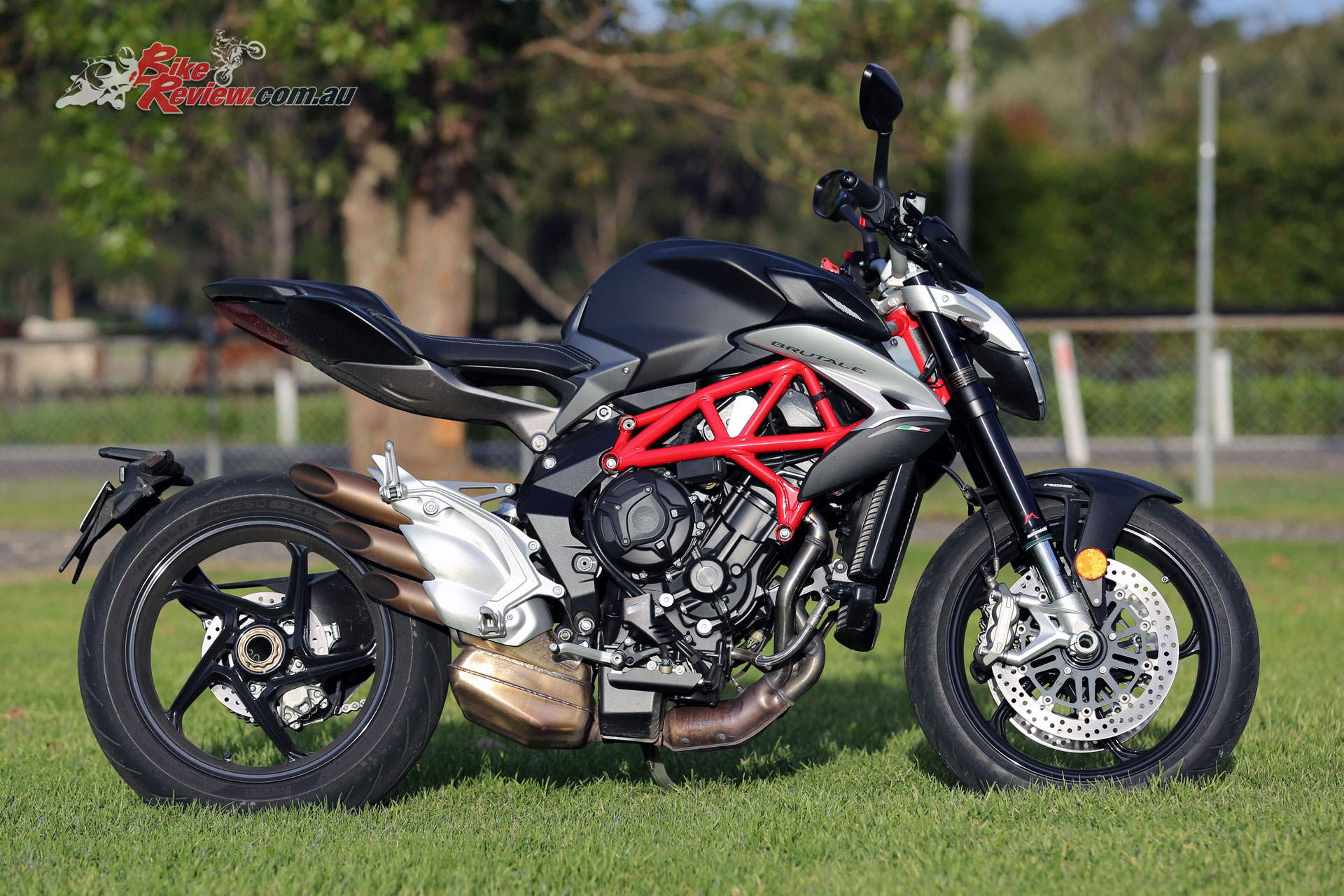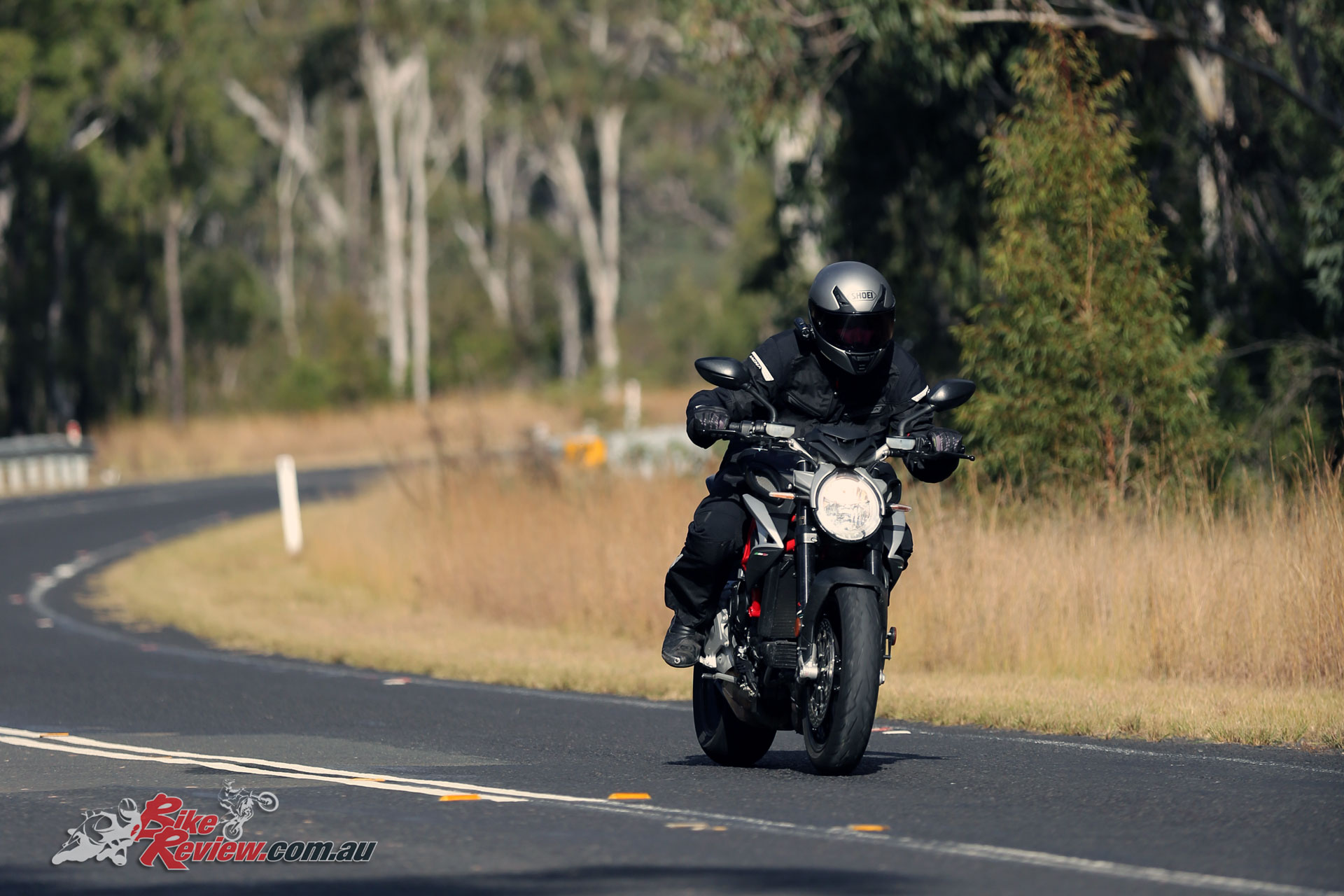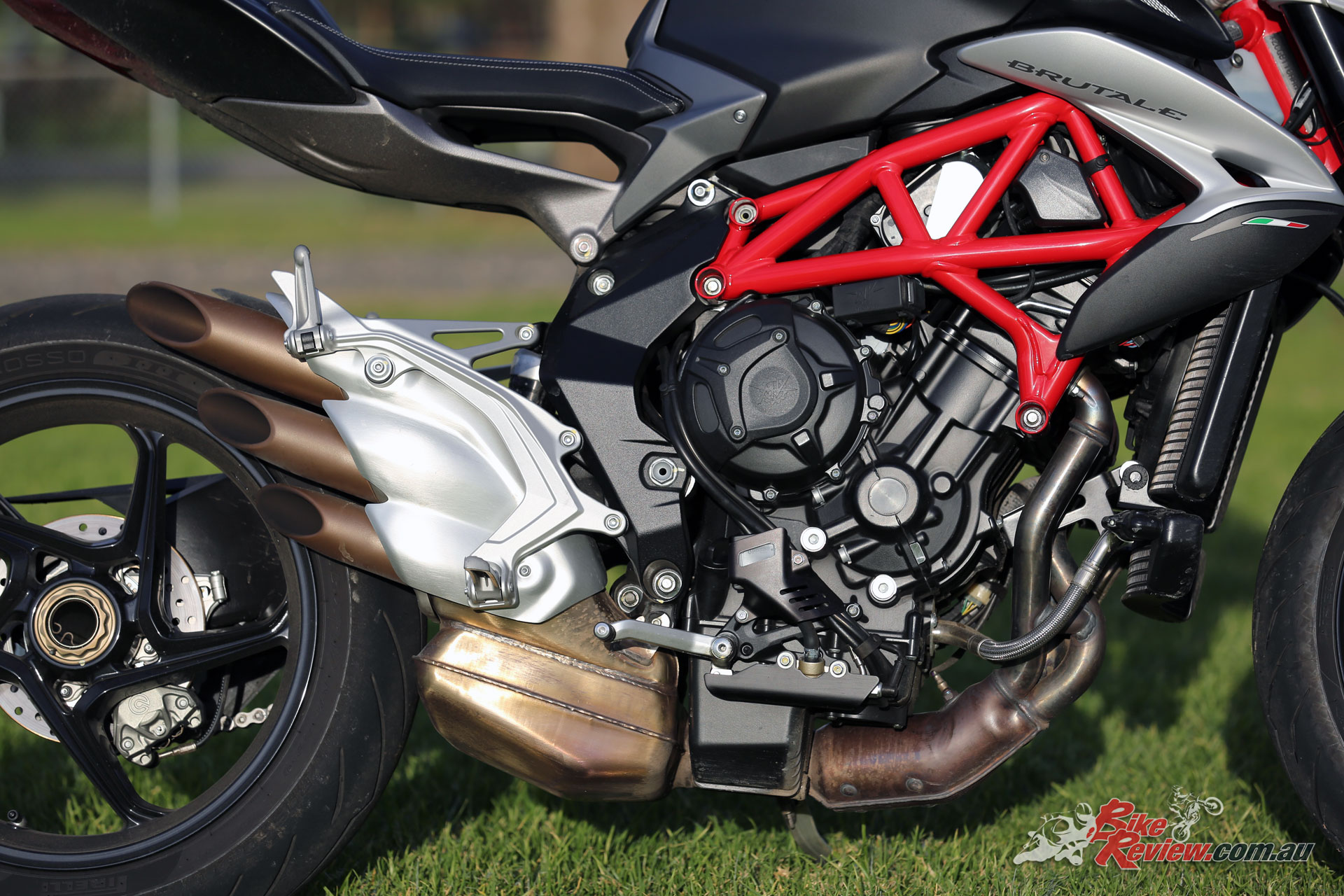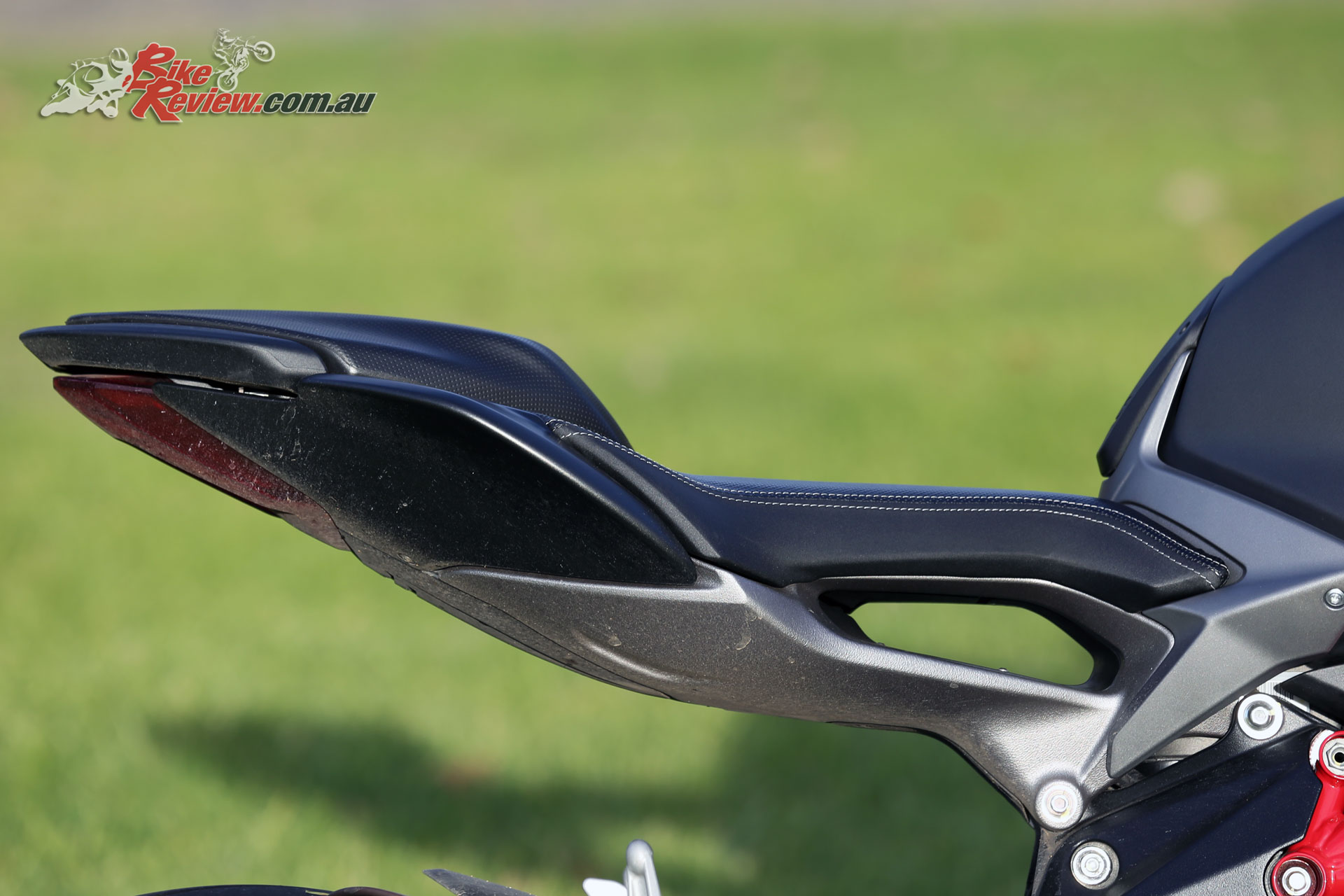Mv Agusta Brutale Dragster 2017
MV Agusta's Brutale 800 is a true no holds barred performance machine with an incredible heritage... Review & Images: Kris Hodgson, David H.
MV Agusta's Brutale 800 is a real standout in the styling department, and combined with that triple-cylinder engine is really an exotic option, with the full electronics package that ensures it has stayed at the cutting edge of motorcycle technology. t 2018 MV Agusta Brutale 800 We tested the Brutale 800 out last year and revisited the model again just recently, and that triple-cylinder engine is still exceptional in most circumstances, with smooth twisties being the Brutale 800s natural hunting grounds. I'm still hoping the Brutale 800, and indeed all the Brutale models still languishing with a single injector per cylinder get the RR treatment, with the Brutale 800 RR and Dragster RR both featuring two injectors per cylinder. It's not about extra power either, the torque on offer is staggering… For the 2017 model, there have been changes, although you wouldn't be able to tell it looking at the bike and I was hard pressed to notice any difference from the 2016 model tested, however MV Agusta are boasting the Ride-by-Wire has been improved, as well updated maps. There's also a new gearbox, rear sprocket and primary gear, aimed at providing positive gear shifts, as well as a new countershaft and reinforced starter system which MV Agusta say offers improved longevity and reliability. One incredibly noticeable issue with the standard Brutale 800 at speeds below 30km/h was hunting, surging on a steady throttle, with plenty of clutch feathering a necessity in these situations, like heavy traffic or through very slow sections (20-40km/h). Having tested both the RRs in the past I know this wasn't an issue for them in comparison. It's not noticeable on the open road, however at low speeds like stuck in traffic below 20km/h fueling is quite rough With that said it's hard to fault the Brutale 800's triple in any other regard. Once moving at a reasonable speed, as was no doubt intended by the Italian engineers, power delivery is instantaneous, with tall gearing ensuring you can really enjoy the grunt. On the freeway third or fourth at 110km/h and above was perfectly comfortable, with that super willing and fast revving triple always ready to deliver. Switch to sport or custom mode and you've activated the up and down quickshifter, which doesn't include an autoblip but is instead used on deceleration. I found it just didn't work on a steady throttle or acceleration, but on deceleration it was faultless. The quickshifter works on upshifts in any mode in comparison and was very smooth, although between first and second giving the bike a bit more speed was definitely the way to go. Hooning off from every set of lights or stop sign is just a given. Tall gearing and an up and down quick shifter thanks to the MV EAS 2.0 system allow you to really get the most out of the triple-cylinder engine It's an exhilarating powerplant and if you've never ridden one you need to try out any of the offerings in the MV Agusta triple line-up, they are subtly different but something that must be sampled! I've always found the MV Agusta models neutral handling, with a telepathic response to input and incredibly light feeling to the bike. That's something even noticeable in their sport-touring machines like the Turismo Veloce and Stradale. This is definitely noticeable on the Brutale 800 as well, with the bike feeling relatively small, but not in any way cramped. It's basically sportsbike ergonomics with a wide and slightly taller set of 'bars, which makes for an engaging ride. 43mm Marzocchi USD forks are fully adjustable and offered good performance on standard settings The front end was well supported and there's a good range of adjustability on offer on both ends, with the rear being far too stiff for my 70kg weight, and offering some quite painful feedback at times over the poorer road surfaces. Couple that with a very firm seat and the ride can be a bit uncomfortable on rough roads and unfortunately we didn't have enough time to try and dial that rear shock in during testing. Handling is telepathic on smooth tarmac although the rear shock was a bit stiff on standard settings It's not a huge problem by any stretch of the imagination, it'll just need to be set to your weight, if like me you don't find it well suited on stock settings. A busy dash gives plenty of information, and you'll be able to see what mode you're using, with Sport and the Standard mode not really offering a noticeable difference to me, except for the quickshifter operating in both directions in Sport. Rain mode offered a more gentle delivery of power, but didn't seem to help that low down surging. MV Agusta Brutale 800, the dash is easily navigable via the left switchblock The Brutale 800 could definitely surprise with its performance but I found it very controllable (within reason), however we had mainly dry conditions and only the usual eternally wet sections of road through the twisties that you expect throughout winter. Through those sections the Rosso III tyres were commendable. The Brembo brake system, backed up by ABS is just a great package, with plenty of power. I can't say I got much use out of the traction control or ABS during testing, even in the cold and sometimes wet conditions the bike was absolutely sure-footed, even turning around in travel for photo stops and similar. The front Brembo brake system is impressive, without being quite at the same level a that found on some of the superbikes, which is ideal on the road There are a few areas that could see some improvement though. While I think the overall styling is inspired, to me the headers and exhaust collector particularly is ugly as sin, sitting exposed underneath the bike, particularly where the three headers merge into a single point. The exhaust system is also so quiet now that the only sound is the bike mechanically. On board it sounds pretty cool, but for an on-looker it's very mechanical and doesn't really have an exhaust note, which is a bit sad. The triple mufflers look cool, but the rest leaves much to be desired. Is it probably required by Euro4, yes, but sad all the same. There's some particularly nice design features on the Brutale 800, like the subframe, tail and red trellis frame In other regards, like the single-sided swingarm, rear subframe, seat, tail, bodywork and premium components like Brembo brakes the Brutale 800 is very much at the pinnacle of the game. As a nakedbike the Brutale 800 stands out from the crowd, it has high spec components and is a significant amount cheaper than the 800 RR, which to me would be well spent on an aftermarket exhaust and tune, solving most of my criticisms in one fell swoop. The Brutale is iconically MV Agusta and well worth investigating Plus it seriously draws the crowd. I had an entire suburban street turn out to not only check out the bike, but also have a good chat with me about it. Then a couple of older gentlemen at a petrol station in a classic car also came to have a look and a chat. Plus a smattering of compliments everywhere I went. I ride a huge variety of motorcycles and that's less common than you might think! MV Agusta Brutale 800 Second Opinion As usual the 800 Brutale is a visually appealing package, with its short wheel base and typical MV Brutale styling. The matt black bodywork is lacking in impact visually to me, though it is offset by the red trellis frame and satin black wheels. The cast rider and pillion seat sub-frame is a fine piece of style and engineering, but this model retains what can only be called a 'dag' on the rear of the rear wheel that mounts the numberplate, rear light and blinkers, so not everything is pure style. [This feature is a bit polarising in the style department.] All the controls fall easily to hand, including the information screen which contains all of the info one expects, with very straight forward access to the bike's ride-by-wire controls by using the mode selector on the RHS handlebar. A simple to use yet surprisingly customisable electronics system makes for a great user experience In fact, the menu system is one of a small number where the systems do not need a manual to make sense. The screen however is a bit odd in that the rev counter bar graph is located at the bottom of the screen. I found this counter intuitive and did not really get used to its position. The same goes for the warning light bar that runs under the main screen on a separate display member. Very easy to miss that you have not turned off a blinker, or that you need fuel! [As corroborated by the other tester.] The main display does change when the fuel warning light comes on, and distance count begins. The fuel trip once triggered counts per 100m (0.1km), but unfortunately appears to reset when fuel is taken on, which also means it resets if the bike is at the right angle for the fuel sensor to think there is more fuel. Sitting on the bike reveals that you sit in it, rather than on it, with the tank rising up in front of you and the pillon seat section providing a good bum stop. The footpegs are positioned low, so your legs/knees have an easy time, while the rear brake and and gear change levers are right in the correct position for easy operation. Wide handlebars can present a small challenge when filtering, but it's something you easily get used to, with good mirror vision and comfortable ergonomics The handle bars are a good reach forward which tips you forward into a comfortable position, with the clutch and front brake lever and the switchblocks falling to hand. The canted forward position balances the wind pressure when moving at speed very effectively. The riding position is very comfortable both in traffic and out on the open road which is a nice change. The seat appears relatively small, but in fact provides a good amount of room to move back or forwards and side to side as the road demands. Its one drawback is that it is very thinly padded and numb bum sets in after two hours, followed by the top edges digging into the thighs which is bloody painful. However, after two hours onboard at speed, a petrol station is required for a fill up of 98RON. Filling up requires a bit of care, otherwise you will have fuel everywhere. The seat is more spacious than it looks, although pillion room is not a priority I had the bike in Sport mode most of the time, as other than rain mode, I really couldn't feel any difference. I used Rain mode for 150kms of heavy fog and very slick road surfaces on a cold early morning ride and it worked very well. The softer throttle response was appreciated in these slippery conditions. The engine is quite noisy, drowning the exhaust at idle and up to around 9000rpm. I found the exhaust was really never heard until well into the upper rev range, and then only when standing by and seeing the bike ridden by. Unusual, as I was expecting the aural delights of the three-cylinder engine to be part of the package. Drawing in the cable operated clutch reduces engine noise, but not by much. Moving off from standstill requires a reasonable number of revs to get the bike moving smartly, but once moving, the free spinning engine settles down nicely, so that keeping up with fast flowing traffic on a major road or freeway is a breeze. The power available is never wanting, even on the freeway where the naked bike riding position is the limiting factor. There's not much wind protection being a nakedbike, with that iconic MV Agusta headlight, however the seating position makes wind less noticeable or concerning, even at speed Maintaining a speed of around 110km/h on a freeway with hills such as the M1 north of Sydney requires some concentration if in fifth or sixth gear, as the bike is not really in its torque range. Fourth gear is much better on these hillier sections even cruising on the freeway, with fifth and sixth gears only used for fuel consumption or way out west on big open roads. At legal speeds the wind pressure is nicely balanced by the canted forward riding position. The clutch is very much like a Japanese mid-sized bike, nicely weighted with a reasonable take up range. Gear shifts both up and down the gearbox using the quick shifter are magic, accomplished with just a slight nudge of the pedal in either direction. To have the quick shifter work seamlessly you need at least 3,000 rpm on the dial. It took me a while to forget using the clutch and just rely on the quick shifter, but once it came together it was a real delight. The front dual Brembo brake system is top notch The Brembo radial front brakes perform as expected, lacking initial bite, but retarding progress smoothly and powerfully. The rear brake is nicely weighted, proving a good balance to the front and allowing trail braking into turns. In fact the brakes work that well I really had to think of their performance. Fuelling is a mixed bag, mode selection does make a slight difference though, with Rain mode providing a better off closed throttle experience, and being good for slippery condition. As seems to be typical for MV's I have ridden, from closed throttle the response is snatchy and poor until around 1500-2000rpm. Above this figure the direct relationship between throttle position and fuelling starts to work and above 6,000 revs the Brutale has a lovely, linear surge of torque and power. In traffic the bike is light and very manoeuvrable, easily able to wend through traffic, and slot down between stationary cars. The wider bars need a bit of concentration at first as they line up with the higher set car mirrors, but once a bit of time has passed, no worries. The 800 has ample power to stay in front of all traffic, or to just mosey along in the traffic, your choice. Faster flowing roads are the real hunting ground for the Brutale 800, where the bike's performance is faultless On faster flowing roads the combination of instant acceleration and powerful brakes make life very enjoyable for the rider. The Pirelli Rosso IIIs obviously play a part in this, even though not the grippiest of Pirelli's road tyres, they are well balanced for a range of road conditions, particularly in the cold and wet. The Brutale can be ridden in the modern square the corner up style or in the traditional arcing, smooth flowing style, it works either way, and it works beautifully. The light weight helps transitioning from side to side as does the seating position, the 'bars provide good leverage as required and the footrests, even though relatively low set, provide good clearance. The suspension works well generally, but the rear end does suffer from being caught out by high ridges or pot holes, where a sharp kick or jolt is felt. The front forks are readily adjustable at the top of each forkleg for damping while the rear shock being hidden in the swing arm does not lend itself to simple spring preload adjustment, and the damping adjustment is hidden away behind the main frame spare on the LHS, making adjustment a little more difficult. Out on the open road is where a Brutale 800 really belongs though. It behaves beautifully in any combination of bends other than low speed hairpins where the snatchyness off closed throttle/low throttle opening can cause problems. Stringing together bend after bend with the bike tipping into corners and following your desired line without deviation, then picking up with application of the throttle to jump out of corners using the mid-range torques is enjoyable and made me smile. The Brutale 800 is an excellent mid-sized nakedbike It behaves well on a trailing throttle where just backing off is enough to retard speed and transitions back onto throttle beautifully as long as you haven't backed right off. In fact it handles that well that the thought of going back and having another run along a section of road is common. In the Brutale 800 MV Agusta have built an excellent mid-sized nakedbike, which very much takes the sporting character seriously. One suitable for an occasional commute, but as I have said above, more at home on the open road and bend swinging through your favourite winding road. To me it still needs some work on the closed throttle/low throttle opening area, and the rear shock adjustability, but these are minor points on such an enjoyable and ridable bike, and isn't that what motorcycling is all about? Taking a quick coffee break with the Brutale 800 at Jerry's before heading for the Putty mvagusta.com.au Claimed power: 81kW[110hp]@11500rpm Engine: Liquid-cooled, in-line three-cylinder, four-stroke, four-valves per cylinder, DOHC, 798cc, 13.3:1 compression, 79 x 54.3mm bore x stroke, Mikuni EFI, MVICS, Eldor 2.0 EMU, RbW, three injectors Gearbox: Cassette style, six speed, constant mesh Suspension:43mm Marzocchi USD forks, fully adjustable, 125mm travel, Progressive Sachs single shock, fully adjustable, 124mm travel Brakes: Bosch 9+ ABS with RLM, dual 320mm floating rotors, Brembo four-piston radial calipers, single rear 220mm rotor, Brembo two-piston caliper Wheels & Tyres: Pirelli Diablo Rosso III tyres, Aluminium alloy five-spoke wheels, 3.50 x 17in, 5.50 x 17in, 120/70 – 17, 180/55 – 17 Dimensions: Instruments: Multi-function digital display









MV Agusta Brutale 800 Second Opinion








2017 MV Agusta Brutale 800 Specifications
Warranty: Two-year, unlimited kilometre
Claimed torque: 83Nm[61.2ft-lbs]@7600rpm
Dry weight: 175kg
Fuel capacity: 16.5L
Clutch: Hydraulically actuated Wet-clutch, multi-disc with back torque limiting device
Chassis: ALS Steel tubular trellis, aluminium alloy single-sided swingarm,Trail: 103.5mm
Wheelbase: 1400mm
Seat height: 830mm
Overall length: 2045mm
Overall width: 875mm 2017 MV Agusta Brutale 800 Gallery
Mv Agusta Brutale Dragster 2017
Source: https://bikereview.com.au/review-2017-mv-agusta-brutale-800/

0 komentar:
Posting Komentar